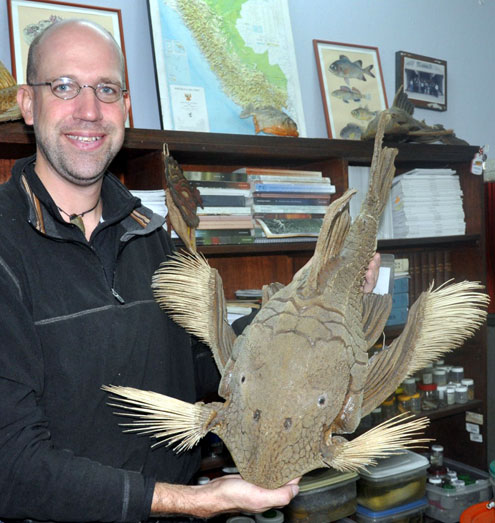 |
School News
Texas A&M researcher discovers three new catfish species that eat wood
By Steve Byrns, Texas A&M
Jan 1, 2012
COLLEGE STATION – ‘Think of them as underwater wood-chippers’ said a Texas A&M University researcher in describing three new species of wood-eating armored catfish from the Amazon he and his team have discovered.
Dr. Nathan Lujan, a postdoctoral researcher in the Winemiller Aquatic Ecology Lab in the department of wildlife and fisheries sciences at College Station, said the three catfish, members of the genus Panaque, are remarkable in that they feed on wood.
“All three of the species we found, indeed, all species in the genus Panaque, feed primarily on wood,” Lujan said. “They have highly specialized, strengthened jaws with teeth-like rasps. You’d think they could digest the wood directly. But they can’t. Instead, they rely on microbes that live in the environment and rapidly colonize submerged wood to break down and ‘digest’ the woody cellulose for them.
“We’ve found that different types of armored catfish that live and graze together have different feeding habits. Some only eat what settles on the surface of the submerged wood, others scrape the surface layers of the wood itself and still another gouges deeply into the wood.”
Lujan said while his team’s discovery is news, finding new fish species in South America is a relatively common occurrence. He has personally helped find and document 22 fish species, including some that were totally new to science and other species that were known to exist, but remained un-described.
“In South America, there are about 3,700 described freshwater fish species and another 1,500 or so that remain un-described,” he said. “The limiting factor for species description is not so much the availability of ‘new species’ as it is the availability of scientists to document them.”
Aside from their wood-eating habits, Lujan said the new catfish are interesting in other ways. One, Panaque schaeferi, can grow to be almost a yard long, likely making it the largest species in the family Loricariidae which contains 800 described species of suckermouth armored catfishes. It is not rare, but it inhabits large hard-to-sample main river channels, making it difficult to study.

Another of the new catfish Panaque armbrusteri, is boldly patterned with alternating brown and black stripes and is already popular as an aquarium fish.
“One of the major obstacles in describing new species is determining whether or not they have already been described,” Lujan said. “That’s usually our first step. We then sometimes have to ‘redescribe’ old species, because the original descriptions may date to the early 1800s,were in a foreign language, specimens were in a deteriorated state or were destroyed in wars or natural disasters.”
Lujan said dam construction is a primary threat to his new discoveries and to the entire Amazon Basin.
“Many species are threatened by the massive disruptions dams cause to once free-flowing rivers,” he said. “The debate over dam development versus conservation of biodiversity and populations of indigenous people is particularly intense in the Brazilian Xingu River where the huge Belo Monte Dam was recently started. The catfish Panaque armbrusteri lives in areas that will be destroyed by Belo Monte.”
Since 2003, Lujan has conducted 11 expeditions to rivers in Venezuela, Guyana, Brazil and Peru. He organized and led about half of these. His fieldwork has been funded by the National Science Foundation, National Geographic and the Explorer’s Club of New York.
Lujan and co-author Dr. Kirk Winemiller, Texas AgriLife Research fisheries scientist and professor at Texas A&M, hope to soon have a manuscript published which focuses on the ecology of wood-eating catfish.
For more information, contact Lujan at 615-579-7234, nklujan@gmail.com .